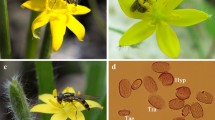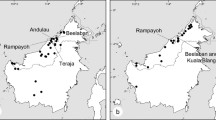Summary
Successful cross-pollination of Monarda fistulosa is the result of a complex interaction among flower opening, the pollen-bearing areas of the pollinators and/or their behavior, and the maturation of the stigmas. The flowers open continuously from 0800–2000 h providing a temporally predictable rich source of nectar and pollen. Recently opened flowers may reduce the ability of bees to discriminate between resource rich and poor patches and encourage systematic foraging within patches. The continuous opening of flowers coupled with protandry also results in some flowers of most capitula being in the staminate and others in the pistillate phase. Autogamy is highly unlikely due to strong protandry and the spatial separation of anthers and stigmas. Geitonogamy, at least that mediated by Bombus is unlikely because the pollen is spread over a relatively large area of the wings, which reduces the likelihood of a stigma contacting just deposited pollen. Because pollen is transferred from the much smaller coxal area of Anthophora and other bees that mistake the stigmas of early pistillate phase flowers for stamens some geitonogamy seems inevitable. However, the delayed receptivity of young stigmas to self-pollen decreases the likelihood of self-pollen germinating on such stigmas. Older stigmas are equally receptive to self- and cross-pollen and the number of pollen grains germinating and pollen tubes reaching the base of the style increases with flower age.
Similar content being viewed by others
References
Bateman AJ (1956) Cryptic self-incompatibility in the wallflower: Cheiranthus cheiri L. Heredity 10:257–261
Beattie AJ (1971) A technique for the study of insect borne pollen. Pan-Pac Entomol 47:82
Bolten AB, Feinsinger P, Baker HG, Baker I (1979) On the calculation of sugar concentration in flower nectar. Oecologia (Berl) 41:301–304
Cruden RW (1972a) Pollinators in high-elevation ecosystems: Relative effectiveness of birds and bees. Science 176:1439–1440
Cruden RW (1972b) Pollination biology of Nemophila menziesii (Hydrophyllaceae) with comments on the evolution of oligolectic bees. Evolution 26:373–389
Cruden RW (1977) Intraspecific variation in pollen-ovule ratios and nectar secretion-Preliminary evidence of ecotypic adaptation. Ann Missouri Bot Gard 63:277–289
Cruden RW, Hermann-Parker SM (1977) Temporal dioecism: An alternative to dioecism? Evolution 31:863–866
Cruden RW, Hermann SM, Peterson S (1983) patterns of nectar production and plant-pollinator coevolution. In: Bentley BA, Elias TS (eds) The Biology of Nectaries. Columbia University Press, New York, pp 80–125
Darwin C (1895) The Effects of Cross and Self Fertilization in the Vegetable Kingdom. D. Appleton and Company, New York
Eisikowitch D, Woodell SRJ (1974) The effect of water on pollen germination in two species of Primula. Evolution 28:692–694
Estes JR, Thorp RW (1975) Pollination ecology of Pyrrhopappus carolinianus (Compositae). Am J Bot 62:148–159
Feinsinger P (1978) Ecological interactions between plants and hummingbirds in a successional tropical community. Ecol Monogr 48:269–287
Gill FB, Wolf LL (1977) Nonrandom foraging by sunbirds in a patchy environment. Ecology 58:1284–1296
Gill LS (1980) reproductive biology of Canadian Labiatae. Phytologia 47:89–96
Heinrich B (1979) Resource heterogeneity and patterns of movement in foraging bumblebees. Oecologia (Berl) 40:235–245
Heslop-Harrison J (1975) The physiology of the pollen grain surface. Proc Roy Soc Lond B 190:275–299
Heslop-Harrison J (1979) Pollen walls as adaptive systems. Ann Missouri Bot Gard 66:813–829
Hiebert SM, Calder WA, III (1983) Sodium, potassium, and chloride in floral nectars: Energy-free contributions to refractive index and salt balance. Ecology 64:399–402
Inouye DW, Favre NA, Lanum JA, Levine DM, Meyers JB, Roberts MS, Tsao FC, Wang Y-Y (1980) The effects of nonsugar nectar constitutents on estimates of nectar energy content. Ecology 61:992–996
Kirby EG, Vasil IK (1979) Effect of pollen protein diffusates on germination of eluted pollen samples of Petunia hybrida in vitro. Ann Bot 44:361–367
Martin FW (1959) Staining and observing pollen tubes in the style by means of fluorescence. Stain Tech 34:125–128
Nettancourt Dde (1977) Incompatibility in Angiosperms. Springer-Verlag, Berlin
Pleasants JM, Zimmerman M (1979) Patchiness in the dispersal of nectar resources: evidence for hot and cold spots. Oecologia (Berl) 41:283–288
Pyke GH (1978a) Optimal foraging in bumblebees and coevolution with their plants. Oecologia (Berl) 36:281–293
Pyke GH (1978b) Optimal foraging: Movement patterns of bumblebees between inflorescences. Theoret Pop Biol 13:72–98
Real LA (1981) Uncertainty and pollinator-plant interactions: The foraging behavior of bees and wasps on artificial flowers. Ecology 62:20–26
Robertson C (1892) Flowers and insects — Labiatae. Trans Acad Sci St Louis. 6:101–131 (in Pamphlets on Pollination No 27)
Sokal RR, Rohlf FJ (1981) Biometry. Second Edition. WH Freeman and Company, San Francisco
Southwick EE, Loper GM, Sadwick SE (1981) Nectar production, composition, energetics and pollinator attractiveness in spring flowers of western New York. Am J Bot 68:994–1002
U.S. Environmental Data Service. Climatological Data, Iowa (1979) 90:7, 8; (1980) 91: 7, 8
Waddington KD, Heinrich B (1981) Patterns of movement and floral choice by foraging bees. In: Kamil A, Sargent T (eds) Foraging Behavior: Ecological, Ethological, and Physiological Approaches. Garland STPM Press, New York, pp 215–230
Waddington KD, Allen T, Heinrich B (1981) Floral preferences of bumblebees (Bombus edwardsii) in relation to intermittent versus continuous rewards. Anim Behav 29:779–784
Weller SG, Ornduff R (1977) Cryptic self-incompatbility in Amsinckia grandiflora. Evolution 31:47–53
Werner PA, Platt WJ (1976) Ecological relationships of co-occurring goldenrods (Solidago: Compositae). Am Nat 110:959–971
Whitehouse HLK (1950) Multiple-allelomorph incompatibility of pollen and style in the evolution of the angiosperms. Ann Bot NS 14:198–216
Whitten WM (1981) Pollination ecology of Monarda didyma, M. clinopodia, and hybrids (Lamiaceae) in the southern Appalachian Mountains. Am J Bot 68:435–442
Willson MF, Burley N (1983) Mate Choice in Plants: Tactics, Mechanisms, and Consequences. Princeton University Press, Princeton
Zimmerman M (1981) Patchiness in the dispersion of nectar resources: Probable causes. Oecologia (Berl) 49:154–157
Author information
Authors and Affiliations
Rights and permissions
About this article
Cite this article
Cruden, R.W., Hermanutz, L. & Shuttleworth, J. The pollination biology and breeding system of Monarda fistulosa (Labiatae). Oecologia 64, 104–110 (1984). https://doi.org/10.1007/BF00377551
Received:
Issue Date:
DOI: https://doi.org/10.1007/BF00377551




